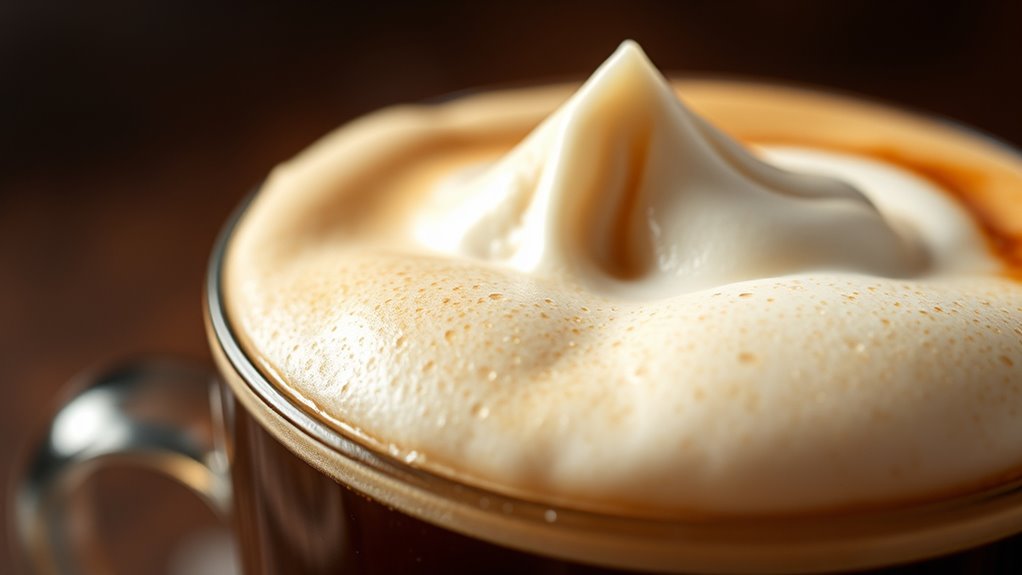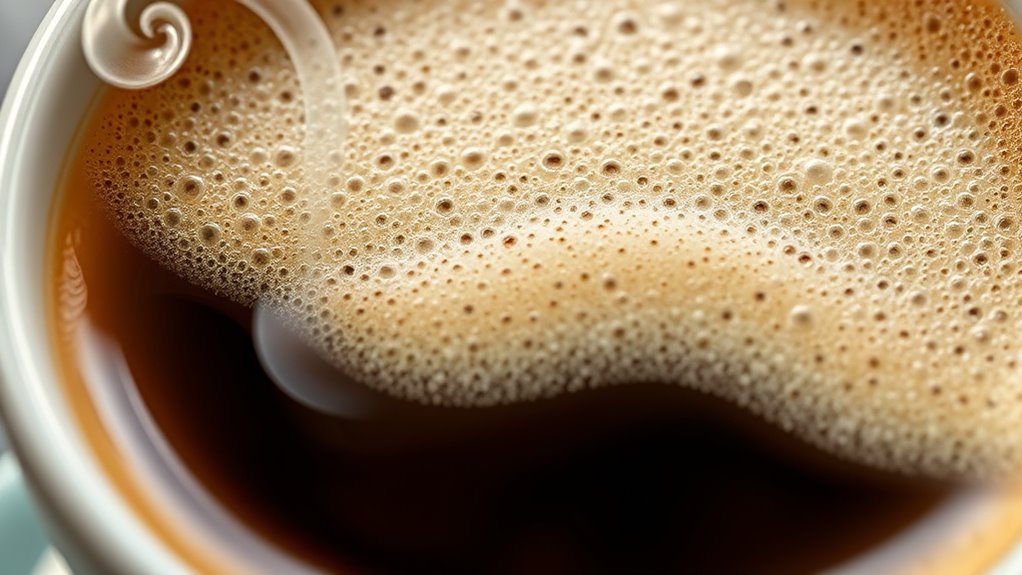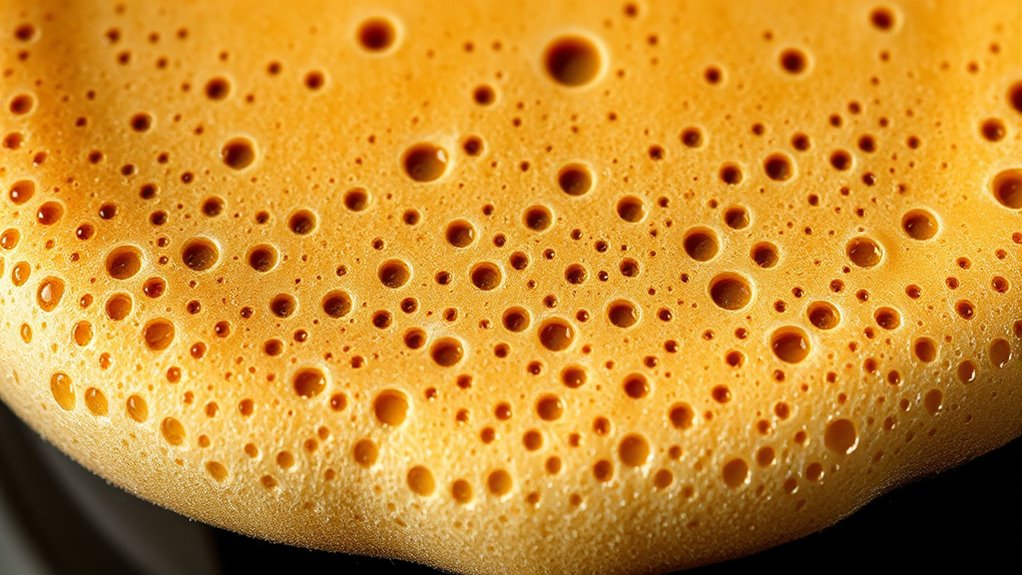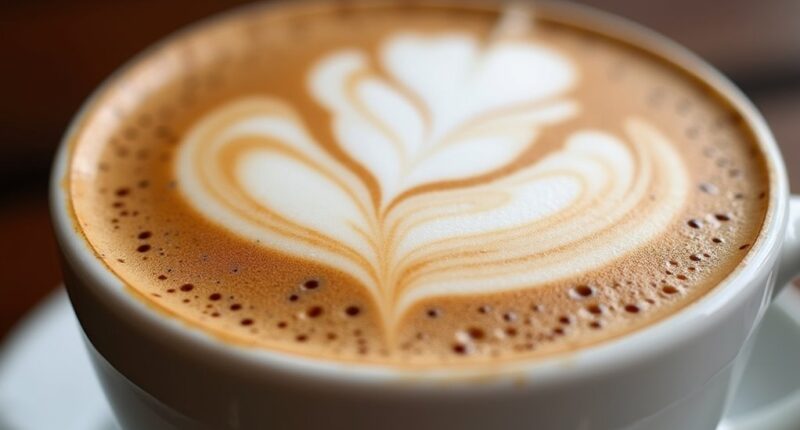Coffee foam, or crema, is that dreamy layer you see on your espresso that’s not just for looks—it’s packed with flavor! It’s made up of tiny gas bubbles, mostly CO2, trapped in liquid, giving it that frothy vibe. Fresh beans and the right milk can amp up the foam’s awesomeness. Forget boring drinks; with the right brew, you’ll feel like a coffee barista. Stick around, there’s plenty more to discover about your favorite cup!
At a Glance
- Coffee foam, known as crema, consists of gas bubbles trapped in liquid, primarily carbon dioxide, enhancing the coffee’s aroma and flavor.
- The quality and freshness of coffee beans significantly impact foam persistence, with fresh beans retaining more gas for better foam.
- Milk proteins play a crucial role in stabilizing coffee foam, while fat content determines the texture, with whole milk offering creaminess.
- Instant coffee surprisingly produces stable foam due to surfactants and particle shape, improving the air-liquid interface for better bubble stability.
- Foam stability is influenced by factors such as roast degree, brewing temperature, and the size of coffee grounds, affecting the overall sensory experience.
Definition and Composition of Coffee Foam

Ever wondered what that lovely, rich layer on top of your espresso is? That’s coffee foam, or as the fancy folks call it, crema!
That delightful layer of richness on your espresso? It’s crema, the fancy name for coffee foam!
It’s a bubbly mix of gas bubbles trapped in a liquid, mostly made of carbon dioxide from the roasting process. Fresh beans keep more gas, giving you that amazing foam persistence.
Picture it: a delicious, velvety texture that lasts about 40 minutes before it decides to take a nap.
Deeper roasts crank out more bubbles, while decaf? Well, it’s like a party pooper—less foam to enjoy. Interestingly, the quality of the decaf espresso can also affect the foam, as some decaf processes retain more flavor compounds than others.
Formation Mechanism and Physical Properties
When you take that first sip of your espresso and spot that gorgeous layer of foam on top, you might wonder how it all comes together.
It’s all about bubble dynamics! As air mixes in during brewing, proteins in milk unfold, creating a cozy bubble blanket. You’ve got hydrophobic sides snuggling up to the air, while the hydrophilic parts keep things watery.
That’s why some coffees, like Robusta, whip up better foam variations! Additionally, the type of coffee grinder you use can affect the extraction process, influencing the foam’s quality.
And remember, smaller bubbles mean a smoother sip.
Instant Coffee and Foam

Instant coffee might not seem like the star of the coffee world, but it packs a punch when it comes to foam! Thanks to its unique instant coffee properties, you’ll find that the foam it creates is surprisingly stable. The surfactants in instant coffee work hard to keep those bubbles intact. Here’s a quick look at why instant coffee foam is special:
| Property | Effect on Foam |
|---|---|
| Surfactant Concentration | Enhances foam stability |
| Particle Shape | Improves air-liquid interface |
| Water Ratio | Strengthens foam structure |
| Additives (like sugar) | Boosts foam longevity |
Moreover, when made with premium instant coffee experiences, the foam can elevate your beverage to a whole new level of enjoyment.
Role of Milk and Its Components in Coffee Foam
You might think that instant coffee steals the spotlight when it comes to foam, but let’s talk about the real heavyweights—milk and its components!
Milk proteins are the foam’s best friends, stabilizing those bubbly clouds we love. The fat content plays a role too; whole milk gives creamy foam, while skim milk makes it light and airy.
If you’re exploring plant-based options, soy milk froths well, but almond milk can be a bit fickle. Additionally, non-dairy creamers can provide a variety of flavors and textures that contribute to your coffee experience.
Ultimately, the right milk boosts foam stability and texture, so you can enjoy that velvety goodness in every sip. Cheers to great coffee foam!
Physical and Chemical Stability of Coffee Foam

Coffee foam might seem like a simple little topping, but it’s got some serious science going on underneath those bubbly surfaces!
You’d be surprised how foam stability factors come into play. The degree of roast and brewing temperature really boost those chemical interactions that keep your foam firm and frothy.
Smaller coffee grounds are like foam superheroes, creating tiny bubbles that stick around longer. Even the freshness of your brew matters! If it’s fresh, it traps more CO2, giving your foam that delightful lift. Additionally, the rich flavors of ground coffee contribute to the overall sensory experience of enjoying a cup, enhancing the appeal of that frothy layer.
Sensory and Aesthetic Importance of Coffee Foam
While it might just look like a frothy topping, the sensory and aesthetic importance of coffee foam is nothing short of magical!
That creamy layer isn’t just for show; it’s all about visual appeal and sensory engagement. When you see that lovely crema, you know your coffee’s fresh and expertly made. The texture adds a velvety touch, making every sip a delight.
Plus, it helps trap those delicious aromas, teasing your taste buds before you even take a drink. The choice of milk used for frothing can greatly influence the overall quality of foam, enhancing your coffee experience even further.





